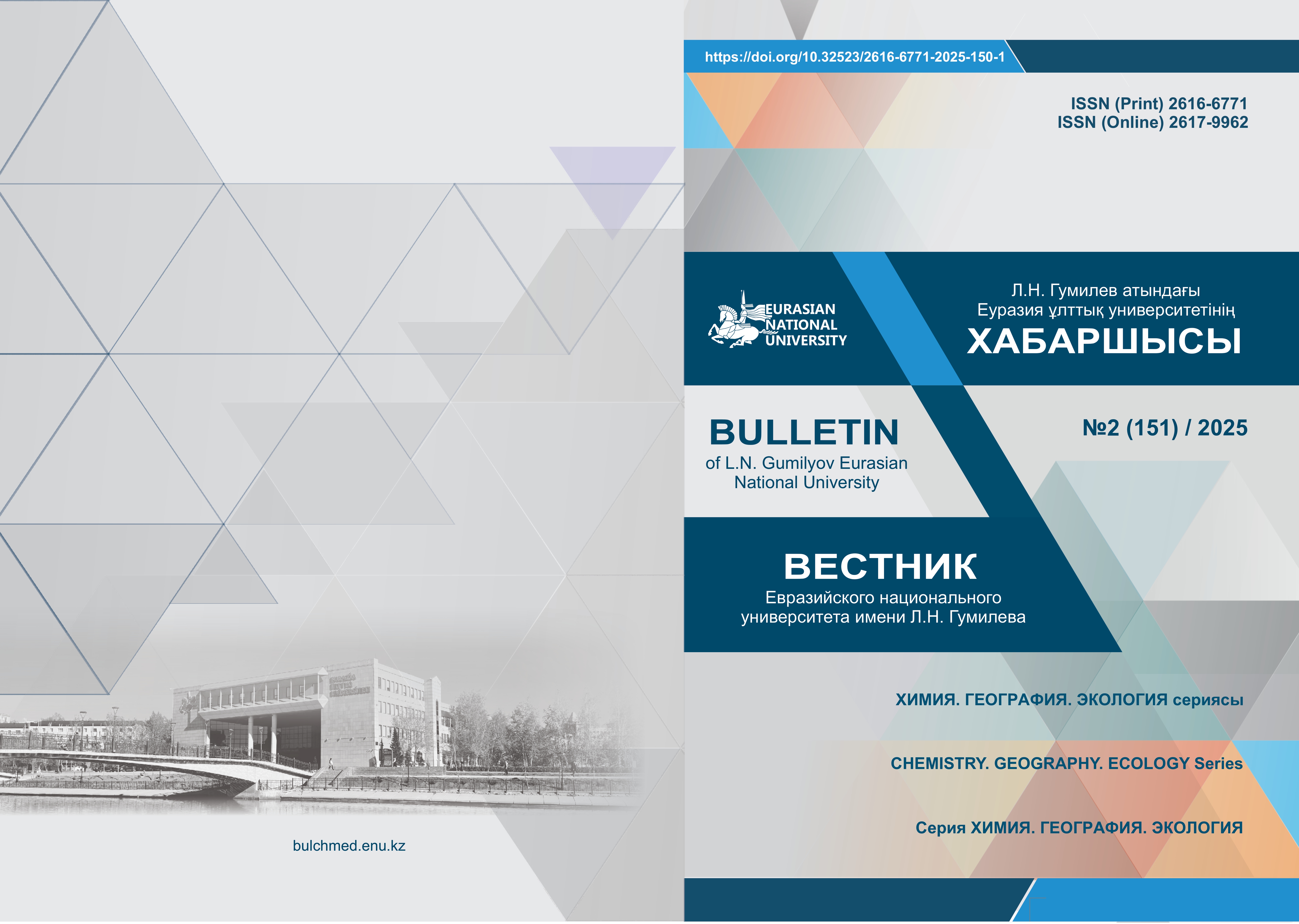Assessment of the natural and recreational potential of the specially protected natural areas of Southern Altai
Views: 1105 / PDF downloads: 121
DOI:
https://doi.org/10.32523/2616-6771-2025-151-2-169-182Keywords:
specially protected natural areas, GIS, operational territorial units, state nature reserve, state national nature park, state natural monument, recreation, tourismAbstract
The assessment of the ecological and recreational potential of protected natural areas in the Southern Altai is an important area of ecological research. This article investigates the ecological condition and recreational opportunities of protected natural areas in the Southern Altai region. Using GIS technology, an electronic map of natural, historical, and cultural monuments in the area was created, and the ecological condition of protected areas and the preservation of their natural resources were evaluated. The relevance of evaluating the ecological and recreational potential of the Southern Altai's specially protected natural areas is explained by the need to preserve unique ecosystems alongside the development of tourism. The study used cartographic materials at a scale of 1:100,000, remote sensing data, and field route results (2015-2024). Firstly, the boundaries of strictly protected areas and point objects (geological, hydrological, botanical monuments) were digitized in the ArcGIS software suite, after which the entire area was divided into 80 hexagonal cells, each with a size of 5x5 km. For each cell, attribute data was collected: the number and type of monuments, the accessibility of infrastructure, and the degree of anthropogenic impact. The important results of this study include the identification of natural monuments and the areas of particular importance for their protection. The Katon-Karagay National Nature Park, the Markakol Reserve, and the geological monuments in the Kurshim district, specifically the Kiyn-Kerish and Kyzyl-Kerish stones, are considered as sites requiring ecological protection. The natural monuments and natural resources in these areas are of particular significance for ensuring ecological stability and preserving the recreational potential of the region.
Downloads
References
Berlyant, A.M. Kartograficheskij metodissledovaniya [Cartographic research method]. – M.: MGU, 1988. – 252 p.
Berlyant, A.M. Geoinformacionnoe kartografirovanie [Geoinformation mapping]. – M.: Pros-veshchenie, 1997. – 64 p.
Chernykh, D.V., Glushkova, M., Pershin, D.K., Zhiyanski, M., Zinovieva, A.E., Zolotov, D.V., Lubenets, L.F., & Biryukov, R.Yu. (2021). Challenges of assessment and mapping of eco-system services in Bulgarian (Rhodope) and Russian (Altai) mountain protected areas in the context of post-socialist transformations and new conservation paradigms. Silva Bal-canica, 22(2), 43–68. https://doi.org/10.3897/silvabalcanica.22.e69861Silva Balcanica
Chervyakov, V.A. Kolichestvennyemetody v geografii [Quantitative methods in geography]. – Barnaul: Izd-voAltGU, 1998. – 260 s.
Chervyakov, V.A. Teoriya i tekhnologiya regional'nogo kartograficheskogo modelirovaniya: geoinformacionnye podhody [Theory and technology of regional cartographic modeling: geoinformation approaches]: monograph. – Barnaul: Izd-vo AltGU, 2005. – 135 s.
Chlachula, J., Zhensikbayeva, N.Zh., Yegorina, A.V., Kabdrakhmanova, N.K., & Czerniawska, J. (2021). Territorial Assessment of the East Kazakhstan Geo/Ecotourism: Sustainable Travel Prospects in the Southern Altai Area. Geosciences, 11(4), 156. https://doi.org/10.3390/geosciences11040156MDPI
Dirin, D.A., Krupochkin, E.P., Golyadkina, E.I. Metodikakompleksnojocenkituristko-rekreacionnogopotencialaregiona[Methodology of comprehensive assessment of the tourist and recreational potential of the region] // Geografiyaiprirodopol'zovanieSibiri. – 2014. – №18. – P. 64-78.
Dunec, A.N. Territorial'naya organizaciya gornyh turistsko-rekreacionnyh sistem: naprimere Altae-Sayanskogo regiona [Territorial organization of mountain tourist and recreational systems: on the example of the Altai-Sayan region]: monograph. – Barnaul: AltGTU, 2009. – 167 p.
Dunec, A.N. Tekhnologii turistsko-rekreacionnogo proektirovaniyai osvoeniya territorij [Tech-nologies of tourist and recreational design and development of territories]: a textbook / AGTU I.I. Polzunova. – Barnaul: AZBUKA, 2011. – 153 p.
Foody, G.M., & See, L. (2006). Data uncertainty in the context of remote sensing and GIS. In-ternational Journal of Remote Sensing, 27(4), 733–736. https://doi.org/10.1080/01431160500251902
García-Hernández, M., de la Calle-Vaquero, M., &Yubero, C. (2017). Cultural heritage and urban tourism: Historic city centres under pressure. Sustainability, 9(8), 1346. https://doi.org/10.3390/su9081346
Gartner, G., & Huang, H. (2018). From conceptual modeling to a map: Cartographic perspec-tives. Proceedings of the ICA, 1, 49. https://doi.org/10.5194/ica-proc-1-49-2018
Geneletti, D. (2013). A GIS-based approach for mapping recreation and tourism potential in protected areas. Landscape and Urban Planning, 111, 1–10. https://doi.org/10.1016/j.landurbplan.2012.11.003
Janelle, D.G., Goodchild, M.F., & Klinkenberg, B. (2003). Spatially Integrated Social Science: Examples in Best Practice. Oxford University Press.https://escholarship.org/content/qt7wp0k0bb/qt7wp0k0bb_noSplash_6a9027530ed318eeea115a8eeab48e87.pdf
Kraak, M.J., &Ormeling, F. (2020). Cartography: Visualization of Geospatial Data (4th ed.). Routledge.https://doi.org/10.1201/9780429464195
Krupochkin, E.P., Dirin, D.A., Popov, E.S., Dunec, A.N. Rezul'taty aprobaci inovoj metodiki kompleksnoj ocenki turistko-rekreacionnogo potenciala: naprimere lentochnyh borov Altajskogo kraya [The results of testing a new methodology for the comprehensive as-sessment of tourist and recreational potential: on the example of ribbon forests of the Altai Territory] // Izvestiya AltGU. – 2012. – №3/2. – P. 245-255.
Kulikova, A., Latysheva, O., &Kotelnikova, A. (2023). Approaches to the design of tourist ar-eas: the experience of the Altai Territory. Bulletin of the L.N. Gumilyov Eurasian National University. Chemistry. Geography. Ecology Series, 143(2), 60–70. https://doi.org/10.32523/2616-6771-2023-143-2-60-70bulchmed.enu.kz
Longley, P.A., Goodchild, M.F., Maguire, D.J., & Rhind, D.W. (2021). Geographic Infor-mation Science and Systems (5th ed.). Wiley.https://www.geos.ed.ac.uk/~gisteac/gis_book_abridged/files/00_fm.pdf
Mammadova, A., Redkin, A., Beketova, T., & Smith, C.D. (2022). Community Engagement in UNESCO Biosphere Reserves and Geoparks: Case Studies from Mount Hakusan in Japan and Altai in Russia. Land, 11(2), 227. https://doi.org/10.3390/land11020227MDPI
Minghini, M., & Brovelli, M. A. (2019). OpenStreetMap history for intrinsic quality assess-ment: Is OSM up-to-date? Open Geospatial Data, Software and Standards, 4(9). https://doi.org/10.1186/s40965-019-0067-x
Nepal, S. K. (2002). Mountain ecotourism and sustainable development: Ecology, economics, and ethics. Mountain Research and Development, 22(2), 104–109. https://doi.org/10.1659/0276-4741(2002)022[0104:MEASDE]2.0.CO;2
Osobo ohranyaemye prirodnye territoriii ob"ekty Altajskogo kraya: karta masshtaba M 1: 1 000 000 [Specially protected natural territories and objects of the Altai Territory: a map of a scale of M 1: 1,000,000]/ edited by I.N. Rotanova, L.N. Purdik, Yu.I. Vinokurova et al. – Barnaul, 2002. – P. 35.
Rotanova, I.N., Harlamova, N.F. Turistko-rekreacionnyj kompleks Altajskogo regiona: organi-zaciyai informacionno-kartograficheskoe obespechenie [Tourist and recreational complex of the Altai region: organization and information and cartographic support]: monograph. – Barnaul: AltGU, 2014. – 212 p.
Sehra, S., Singh, J., & Rai, H. (2017). Assessing OpenStreetMap data using intrinsic quality indicators: An extension to the QGIS processing toolbox. Future Internet, 9(2), 15. https://doi.org/10.3390/fi9020015
Simangan, D.A., & Eslava, J.L. (2023). A mathematical model for assessing tourism potential in protected areas. Tourism Management, 94, 104660. https://doi.org/10.1016/j.tourman.2022.104660
Tikunov, V.S. Modelirovanie v kartografii [Modeling in cartography]. – M.: MGU, 1997. – 235 p.
UNEP-WCMC. (2023). World Database on Protected Areas (WDPA). Retrieved from https://www.protectedplanet.net
Vancura, V. (2016). Wilderness and tourism in Altai Mountains, Kazakhstan. European Wil-derness Society. Retrieved from https://wilderness-society.org/wilderness-tourism-altai-mountains-kazakhstan/European Wilderness Society
Zoltan, J., & Bausch, T. (2016). Tourism planning and development in mountainous areas: Challenges and approaches. Tourism Geographies, 18(3), 306–323. https://doi.org/10.1080/14616688.2016.1144643
Downloads
Published
Issue
Section
License
Copyright (c) 2025 Nazgul Zhensikbayeva, Nurgul Ramazanova, A. Yeginbayeva, Nazerke Amangeldy (Author)

This work is licensed under a Creative Commons Attribution-NonCommercial 4.0 International License.








